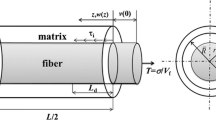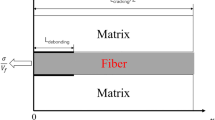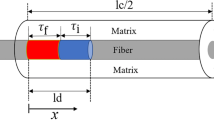Abstract
A fracture mechanics based methodology for the determination of interface fracture toughness from crack spacing in a thin coated fiber is presented. The coating (film) may be regarded as the matrix material in typical experiments employing this configuration. Matrix crack spacing is considered to be the result of a competitive process between matrix segmentation and interface debonding which are assumed to be governed by critical energy release rate criteria. Matrix cracks are assumed to form by the process of channeling in the circumferential direction and steady state conditions are assumed at the matrix crack front in the channeling direction. Energy release rates are determined using domain integral procedures in conjunction with the finite element method. The minimum crack spacing is obtained as a function of applied stress for different values of interface fracture toughness. A methodology to relate the saturated crack spacing to interface fracture toughness is developed. Interfaces are classified into three categories: weak, intermediate and strong. It is shown that in experiments of this type, quantitative information about the interface fracture toughness can be obtained for intermediate interfaces while qualitative information may be obtained for weak and strong interfaces.
Similar content being viewed by others
References
J. Aveston, G.A. Cooper and A. Kelly, The Properties of Fiber Composites. Conference Proceedings, National Physical Laboratory, IPC Science and Technology Press, Ltd. (1971) Paper I, 15–26.
J.Aveston and A.Kelly, Theory of Multiple Fracture of Fibrous Composites. Journal of Materials Science 8 (1973) 352–362.
D.C.Agrawal and R.Raj, Measurement of the Ultimate Shear Strength of a Metal-Ceramic Interface. Acta Metallurgica 37: 4 (1989) 1265–1270.
J.W. Lee and I.M. Daniel, Deformation and Failure of Longitudinally Loaded Brittle-Matrix Composites. Composite Materials: Testing and Design, ASTM STP 1120 (1992) 204–221.
Q.Guo, H.Osaki, S.M.Keer and D.R.Wheeler, Measurement of the Intrinsic Bond Strength of Brittle Thin Films on Flexible Substrates. Journal of Applied Physics 68: 4 (1990) 1649–1654.
F.W.Zok and S.M.Spearing, Matrix Crack Spacing in Brittle Matrix Composites. Acta Metallurgica et Materialia 40:8 (1992) 2033–2043.
B.Budiansky, J.W.Hutchinson and A.G.Evans, Matrix Fracture in Fiber-reinforced Ceramics. Journal of the Mechanics and Physics of Solids 34:13 (1986) 167–189.
Y.Weitsman and H.Zhu, Multi-fracture of Ceramic Composites. Journal of the Mechanics and Physics of Solids 41:2 (1993) 351–388.
J.W.Hutchinson and H.M.Jenson, Models of fiber Debonding and Pullout in Brittle Composites with Friction. Mechanics of Materials 9 (1990) 139–163.
S Ochiai and Y. Murakami, The Strengthening Effects of Brittle Zones on Ductile-Fiber Composites. Metal Science (1976) 401–408.
R.A.Lowden and D.P.Stinton, Interface Modification in Nicalon/SiC Composites. Ceramic Engineering Science Proceedings 9:7–8 (1988) 705–722.
A. Cazzato and K.T. Faber, Multiple Cracking and Debonding of a Brittle Film on a Ductile Road. Ceramic Engineering Science Proceedings 14 (1993).
M.D.Thouless, Crack Spacing in Brittle Films on Elastic Substrates. Journal of the Americal Ceramic Society 73:7 (1990) 2144–2146.
H.Tada, P.Paris and G.Irwin, The Stress Analysis of Cracks Handbook, 2nd edn., Paris Productions, St. Louis (1985).
J.L.Beuth, Cracking of Thin Bonded Films in Residual Tension. International Journal of Solids and Structures 29:13 (1992) 1657–1675.
R.Nahta and B.Moran, Crack Spacing in Brittle Films on Dissimilar Planar and Axisymmetric Elastic Substrates. Engineering Fracture Mechanics 52:3 (1995) 513–524.
J.W.Hutchinson and Z.Suo, Mixed Mode Cracking in Layered Materials, in Advances in Applied Mechanics, vol. 29, J.W.Hutchinson and T.Y.Wu (eds.) Academic Press, San Diego (1990) 63–191.
T.Nakamura and S.M.Kamath., Three-dimensional Effects in Thin Film Fracture Mechanics. Mechanics of Materials 13 (1992) 67–77.
T.R.Rice, Elastic Fracture Mechanics Concepts for Interfacial Cracks. Journal of Applied Mechanics 55 (1988) 98–103.
R.Nahta and B.Moran, Domain Integrals for Axisymmetric Interface Crack Problems. International Journal of Solids and Structures 30:15 (1993) 2027–2040.
Author information
Authors and Affiliations
Rights and permissions
About this article
Cite this article
Nahta, R., Moran, B. Film cracking and debonding in a coated fiber. Int J Fract 79, 351–372 (1996). https://doi.org/10.1007/BF00018596
Received:
Accepted:
Issue Date:
DOI: https://doi.org/10.1007/BF00018596




